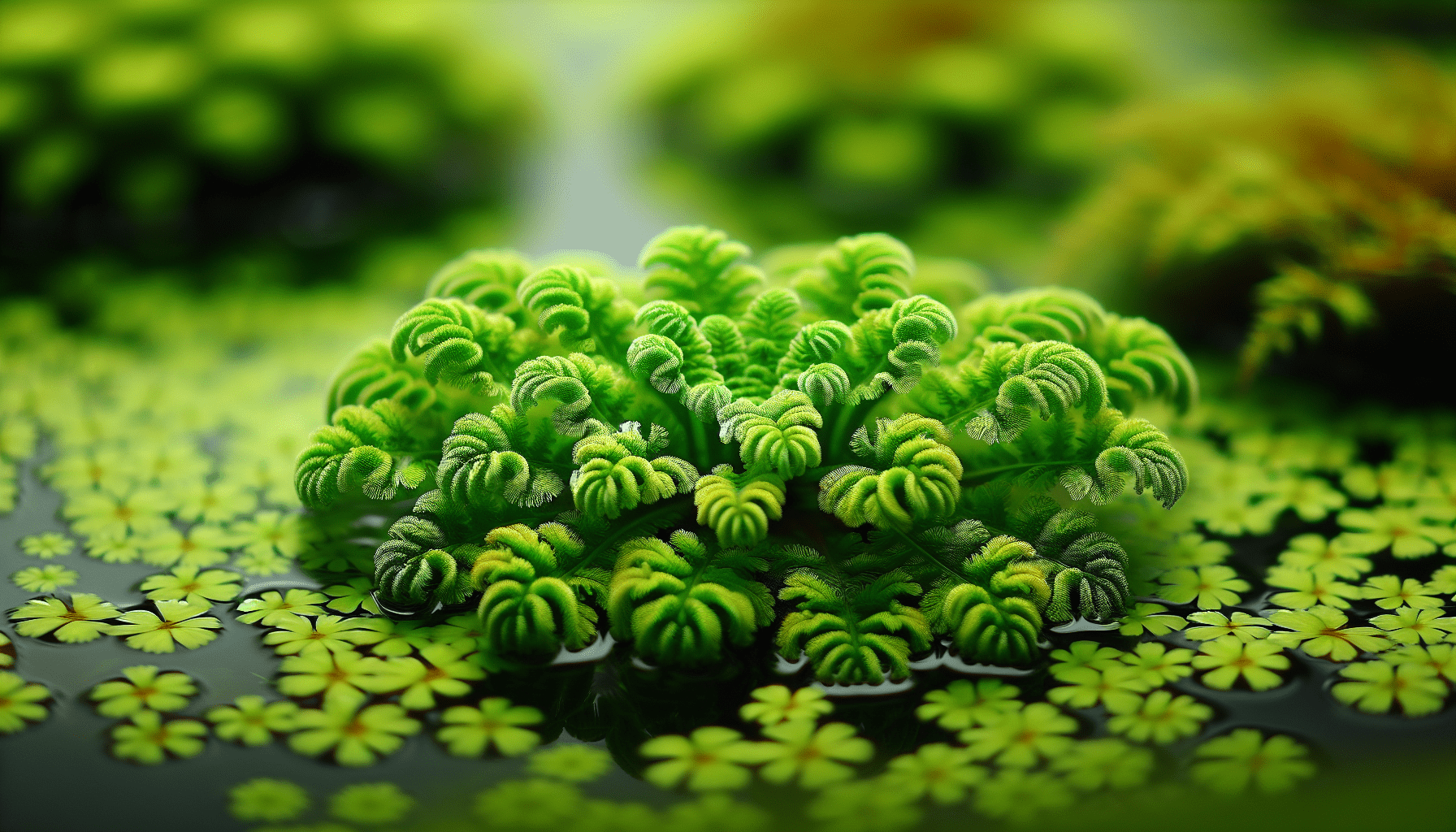Engaging in an exploration of the aquatic plant Azolla Cristata, you will embark on a journey unlocking intricate details of its taxonomy, ecology, and potential applications. In this detailed study, an in-depth understanding of this peculiar water plant will be established, offering you highly informative insights into its characteristics, along with its biological and environmental features. As you navigate through the details encapsulated herein, you are sure to attain an enlightening perspective on this unique aquatic weed.
Defining Azolla Cristata
As we delve into understanding the world of aquatic flora, Azolla Cristata emerges as a species of particular interest. This aquatic fern, belonging to the family of ‘Azollaceae,’ displays distinct characteristics and exhibits an intriguing life cycle.
Scientific Classification of Azolla Cristata
Azolla Cristata falls under the kingdom Plantae. It belongs to the class Polypodiopsida and the order Salviniales. Further down the scientific classification, it is part of the family Azollaceae and the genus Azolla. As reflected in its binomial name, ‘Cristata’ is the specific epithet of this species.
Common Names and synonyms
In common parlance, Azolla Cristata is often known as Mosquito fern. An alternative name for it is Fairy moss. It goes by several synonyms, including Azolla japonica, Azolla sikkimensis, and Azolla squamosa. These different terms reflect the plant’s presence and recognition across various regions and cultures.
Reflection on the Name ‘Azolla Cristata’
Considering the origin of its name, ‘Azolla’ stems from Greek, where ‘azos’ means dry and ‘olla’ means moss. The term ‘Cristata,’ on the other hand, signals the wavy or crested nature of the plant’s morphology. Thus, the name articulates inherent characteristics of the plant, a practice typical in plant taxonomy.
The Natural Habitat of Azolla Cristata
Azolla Cristata is known for its adaptive capabilities, enabling it to thrive in diverse environments.
Geographical Distribution
Azolla Cristata is native to Asia, primarily found across Japan, China, and India. However, it has spread to many regions worldwide and is now seen ubiquitously in the north temperate zone, including North America.
Preferred Climatic Conditions
The plant is remarkably adaptable to varying climates. It prefers a temperate climate but can also thrive in subtropical and tropical conditions.
Commonly Found Waterbodies
Azolla Cristata is found primarily in still or slow-moving freshwater bodies. These consist of ponds, lakes, marshes, and even rice fields where the plant often forms an extensive layer of vegetation floating on the water surface.

Physical Characteristics of Azolla Cristata
Azolla Cristata exhibits distinct morphological traits, defining its physical identity.
Size and Shape
The plants are generally small, measuring less than 1 cm in length, with the entire plant, including roots, stretching to about 2.5 cm. The leaves are imbricate, alternately arranged, and possessing a slightly overlapping appearance.
Color and Appearance
The color of Azolla Cristata is generally a lush green, although it can take on a reddish hue depending on nutrient availability and light intensity. It has lacy, finely-divided leaves that give it the appearance of a delicate mass when floating on water bodies.
Uniqueness in Growth Pattern
A distinctive characteristic of Azolla Cristata is its fast-growing nature. It forms dense mats on the surface of water bodies, blocking sunlight penetration and suppressing the growth of competing flora.
Underlying Root System
Azolla Cristata has a unique root system, with only one root hanging down in the water from each stem node. The roots are usually short and unbranched, thereby facilitating buoyancy.
Life Cycle of Azolla Cristata
The life cycle of Azolla Cristata intersperses vegetative and sexual methods of reproduction.
Growth Stages and Rate
Azolla Cristata has a rapid growth rate. It can double its biomass within a mere couple of days under favourable conditions. The fern’s life cycle begins with germination of the spores, followed by a swift vegetative growth phase, leading to mat formation.
Reproduction Methods
Azolla Cristata employs a dual method of reproduction, potentially vegetative through fragmentation and sexual through sporulation. The plant’s spores are heterosporous, producing two types of spores: microspores (male) and megaspores (female).
Longevity and Lifespan
The longevity of Azolla Cristata primarily depends on surrounding conditions. In general, it is annual, although perennial growth is observed under favourable conditions.

Ecological Impact of Azolla Cristata
Azolla Cristata can significantly influence the ecology of its environment, carrying both beneficial and adverse impacts.
Azolla Cristata as A Biofertilizer
Given its ability to bind atmospheric nitrogen, Azolla Cristata acts as a biofertilizer, thus, enriching soil fertility. Applying the plant to rice fields has traditionally been a practice in many oriental countries, improving crop yield without relying on chemical fertilizers.
Impact on Water Quality
While Azolla Cristata can potentially improve water quality by sequestering nutrients, their extensive mats can also decrease oxygen levels in the water, leading to anoxic conditions which can adversely affect aquatic life.
Effects on Native Species
The dense growth of Azolla Cristata can lead to diminished sunlight penetration into the water and reduced oxygen levels, impacting the growth of other aquatic flora and fauna.
Economic Importance of Azolla Cristata
Azolla Cristata’s economic significance revolves around its usage across several vital industries.
Use in Aquaculture
In aquaculture, Azolla Cristata is utilized as a feedstock. Its high protein content and rich composition of vitamins and minerals render it a nutritious feed for various aquatic fauna.
Implication in Agriculture
Beyond acting as a biofertilizer, Azolla Cristata, owing to its pest-resistant traits, can also help control pests in rice fields, reducing the need for synthetic pesticides.
Contribution to Biomass Production
Azolla Cristata is also recognized as a source for biomass production due to its rapid growth rate and ability to effectively convert solar energy.
Potential Hazards of Azolla Cristata
While Azolla Cristata carries many benefits, the plant’s invasive nature can also create issues.
Threat to Biodiversity
When Azolla Cristata spreads aggressively in a habitat, it can harm aquatic biodiversity. It can out-compete native species for resources and disrupt ecological balances in the water body.
Interference with Water Utilization
Besides biodiversity, Azolla Cristata can impact water utility. Its dense mats can interfere with irrigation as well as recreational activities, creating a nuisance.
Management and Control Challenges
Lastly, Azolla Cristata can also pose challenges in terms of control and management. Its fast growth and wide dispersal make it difficult to control, often requiring sustained and coordinated efforts.
Strategies for Controlling Growth of Azolla Cristata
Effective control of Azolla Cristata requires a range of strategies.
Chemical Control Methods
These involve the use of herbicides to control growth. However, the implications on non-target species and the environment need to be considered.
Biological Control Methods
Certain organisms, like the weevil Stenopelmus rufinasus, can control Azolla Cristata by feeding on the fern.
Physical Control Methods
These methods involve manually removing the fern from the water bodies, which can be labor-intensive and time-consuming.
Researches and Studies on Azolla Cristata
Studies on Azolla Cristata provide valuable insights into its characteristics and potential uses.
Key research Findings
Research has illuminated Azolla Cristata’s role as a biofertilizer and its potential in carbon sequestration and as a feedstock.
Ongoing Studies
Current studies are exploring Azolla Cristata’s use in wastewater treatment, bioenergy production, and nutrient management.
Potential Areas for Future Research
There is scope to further understand the genetic basis of Azolla Cristata’s rapid growth and its symbiotic association with nitrogen-fixing cyanobacteria. Greater clarity in these areas can lead to more effective utilization of this aquatic fern.
Closing Thoughts on Azolla Cristata
Understanding Azolla Cristata requires a holistic approach that balances both its utility and invasiveness.
Balance Between Use and Control
Azolla Cristata presents a dichotomy where the same growth characteristics that make it valuable in agriculture and aquaculture also make it a potential nuisance. Achieving a balance between use and control is crucial for sustainable utilization of Azolla Cristata.
Reflection on Human-Nature Interaction
Azolla Cristata also serves as a reflection of our broader interaction with nature. While we attempt to harness natural resources for societal advancements, checks and balances must be in place to prevent ecological threats and sustain biodiversity. In this context, our understanding and management of Azolla Cristata could serve as a symbol of our broader awareness of environmental stewardship.